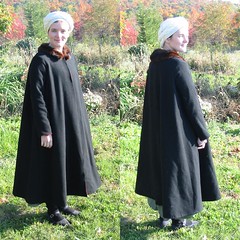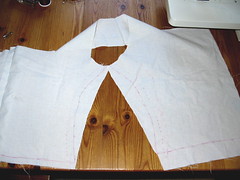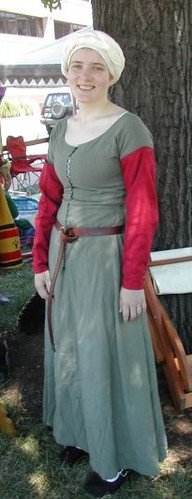This wasn't one of my most heavily researched projects, but it was made from just materials on hand, and is fairly period. I mostly based it around woodcuts at Myra's schaube documentation. The Curious Frau's schaube dress diary also has good images (although the style shown is a bit later). The short length is unusual, but it's very convenient, and there is at least a little evidence for it.
It is made of a coat-weight wool, and fully lined in a bright red linen. The fur collar is a piece I inherited (it went with a matching stole) - mink, I think. You can't see it at all in the photo, but it closes at the neck with a cast pewter button (which happens to feature the device of my favorite Barony :-) ); I've got additional buttons that I plan to add eventually, but even one button does a good job of keeping the coat closed.
I definitely prefer a coat like this over a cloak; it kept me warm in chilly, windy weather this weekend, and I didn't have to take it off to shoot (a little tricky with the quiver, though). If I was going to make another one, I think the sleeves are too narrow, and I'm not totally happy with the A-line look of it. I think that's mostly a function of the stiffness of the wool, so I'm hoping it may soften up with more use.
24 October 2006
19 October 2006
Guarded optimism
I've cut all the main pieces for the kampfrau gown. The fabric is a fairly heavy wool melton in a muted green - the same fabric that I used for the 1470s Burgundian gown. I found scraps big enough for the bodice back and cuff pieces; the bodice front and sleeves (on the bias) were cut from my remaining yardage as efficiently as I could manage, and there was just barely enough left for two skirt panels (full fabric width ~59" x waist to hem ~39"). There really aren't any pieces left that are big enough to do anything with. I don't have anything on hand that would work well for interlining, so a lot of the construction is going to have to wait until I can get some ordered. I've got lightweight linen for the lining, but I don't want to cut that until I'm almost ready to put it in.
That just leaves cutting the guards from my accent fabric (a fulled and napped medium-heavy black wool). The skirt guards are clear enough, since they're just straight strips. The guarding for the top, on the other hand, threw me for a bit of a loop. The only guidance from the pattern is straight strips 2 or 3 inches wide. One option would be to use rectangular strips and piece them around the neckline, making joins at the corners. The other option is to use a pre-shaped piece that echoes the edge of the neckline. Two considerations pushed me toward the second option. First, since my guards will be slashed, I really want as much structual integrity as possible - the bulk of seams and joins won't help in getting smooth and even slashing. Second, most of other people's reproductions that I really admire seem to use continuous, shaped pieces - or at least they look that way in photos. It's much more apparent that this is the way to go with the slightly earlier, more rounded neckline.
So I ended up doing guard pieces that are essentially cut-outs of the front and back pieces. I started 5/8" in from the neckline and center front opening (to allow room for finishing without losing guard width) and made them an even 2" wide. The plan is to attach them after doing the interlining, but before totally assembling the bodice with the lining.
My only remaining question is how exactly to do the slashes. I'm afraid that if I just cut a slit, the fabric behind won't really show through, so I might need to do a slightly wider cutout that actually removes material. I'm hoping that's not the case though, since I think I'd have trouble getting the cutouts to be even and consistent. Stitching the guards down might stretch the opening enough to make the slash noticeable, but I don't know if it'll be enough. I suppose I'll just have to experiment with some scraps.
That just leaves cutting the guards from my accent fabric (a fulled and napped medium-heavy black wool). The skirt guards are clear enough, since they're just straight strips. The guarding for the top, on the other hand, threw me for a bit of a loop. The only guidance from the pattern is straight strips 2 or 3 inches wide. One option would be to use rectangular strips and piece them around the neckline, making joins at the corners. The other option is to use a pre-shaped piece that echoes the edge of the neckline. Two considerations pushed me toward the second option. First, since my guards will be slashed, I really want as much structual integrity as possible - the bulk of seams and joins won't help in getting smooth and even slashing. Second, most of other people's reproductions that I really admire seem to use continuous, shaped pieces - or at least they look that way in photos. It's much more apparent that this is the way to go with the slightly earlier, more rounded neckline.
So I ended up doing guard pieces that are essentially cut-outs of the front and back pieces. I started 5/8" in from the neckline and center front opening (to allow room for finishing without losing guard width) and made them an even 2" wide. The plan is to attach them after doing the interlining, but before totally assembling the bodice with the lining.
My only remaining question is how exactly to do the slashes. I'm afraid that if I just cut a slit, the fabric behind won't really show through, so I might need to do a slightly wider cutout that actually removes material. I'm hoping that's not the case though, since I think I'd have trouble getting the cutouts to be even and consistent. Stitching the guards down might stretch the opening enough to make the slash noticeable, but I don't know if it'll be enough. I suppose I'll just have to experiment with some scraps.
17 October 2006
Kampfrau gown - initial mock-up
I'm starting a new project: a Kampfrau gown in green with black guards, to look very much like this one. I'll be using Reconstructing History's pattern for 1520s German Commonwoman's Gowns, which is unusual for me (I typically draft my own). I picked the colors based on what I have enough leftover yardage of, but I thnk the scheme will work. I just need to remember not to go with green next time I buy for a big project so that I don't end up too monochromatic ^_^
So far, I've made and fitted a muslin mock-up for the main bodice pieces (shown above - back on the left and front on the right). The pieces were traced directly from the pattern; the solid pink lines mark my new cutting lines. It's worth noting that the front piece is about an inch long than the back piece at the side seam - this is on purpose and the pieces should be eased to fit, but the directions don't actually mention that. I ended up losing the ease in the course of multiple pinnings and adjustments, which is why I needed to trim off much more on the front than the back. Although in the end it looks like I just worked the side seam in symmetrically, the intermediate stages looked a lot less similar to the original pieces. I've thought about trying to draft the ease back in before cutting my main fabric, but I'm not sure it would be worth it. I do wish the pattern had marked an underbust adjustment point (rather than just chest and waist at the top and bottom corners) - that would have saved me a lot of grief in drawing out the initial pattern. I should have known better, since I'm fairly familiar with the 15th c. supportive styles, but you need a snug fit in the ribcage in order to get some support from a gown, and I just wasn't going to get that from the straight-edged pieces that I started with. Fortunately, the straps and neckline seem to work for me without adjustment.
15th c. Flemish working-class a la van der Weyden's Magdalena
This is the first outfit I made specifically for the SCA and with an eye to historical accuracy. Previously, I'd done a fair bit of sewing, but directed toward the theatrical, Renfest, and cosplay end of the spectrum.
My direct inspiration for this gown was van der Weyden's 'Deposition', although I should note that this style is not restricted to depictions of Mary Magdalene. It seems to have been the basic working woman's dress of the 15th century; without oversleeves when working in the fields or the kitchen, with sleeves when in more public settings.
The gown itself is made of a lightweight worsted wool, unlined. I used a four-panel, three-gore (sides and back) construction, with raglan-cut short sleeves. I have material for a fourth gore that I have always intended to set into the front seam, but it seems increasingly unlikely that I ever will. The gown is not a self-supporting one - this is partly because it is unlined, and wool is moderately stretchy, but mostly because it was not sufficiently fitted for that. As a result, I now always wear this dress with a more tightly fitted linen underdress that provides support. Ideally, that would be the lining for the gown rather than a separate item, but it is functionally equivalent. The gown laces through 8mm sterling silver jump rings, soldered closed. They were bright and shiny when new, but quickly tarnished to a nice dark patina. This was all handsewn with silk thread.
The red pin-on sleeves are a poly-cotton damask and machine sewn. Each has two fabric-ball buttons at the wrist for a closer fit. The head wrap is a simple, very long rectangle of fine linen. The leather belt was made for me by my husband, using purchased brass reproduction hardware. I am also wearing a linen chemise (long sleeved, mid-calf length) and linen knee-high hose.
My direct inspiration for this gown was van der Weyden's 'Deposition', although I should note that this style is not restricted to depictions of Mary Magdalene. It seems to have been the basic working woman's dress of the 15th century; without oversleeves when working in the fields or the kitchen, with sleeves when in more public settings.
The gown itself is made of a lightweight worsted wool, unlined. I used a four-panel, three-gore (sides and back) construction, with raglan-cut short sleeves. I have material for a fourth gore that I have always intended to set into the front seam, but it seems increasingly unlikely that I ever will. The gown is not a self-supporting one - this is partly because it is unlined, and wool is moderately stretchy, but mostly because it was not sufficiently fitted for that. As a result, I now always wear this dress with a more tightly fitted linen underdress that provides support. Ideally, that would be the lining for the gown rather than a separate item, but it is functionally equivalent. The gown laces through 8mm sterling silver jump rings, soldered closed. They were bright and shiny when new, but quickly tarnished to a nice dark patina. This was all handsewn with silk thread.
The red pin-on sleeves are a poly-cotton damask and machine sewn. Each has two fabric-ball buttons at the wrist for a closer fit. The head wrap is a simple, very long rectangle of fine linen. The leather belt was made for me by my husband, using purchased brass reproduction hardware. I am also wearing a linen chemise (long sleeved, mid-calf length) and linen knee-high hose.
Labels:
15th c.,
Flemish working class,
showcase
16 October 2006
Introduction and Welcome
I've decided to split off my dressmaking projects and other sewing activities from my general purpose social blog (which can be found here). I plan to have commentary and progress pictures of ongoing projects, as well as showcasing completed items, thoughts on recreation methods and theories, maybe articles on specific topics and techniques, and anything else sewing-related that strikes my fancy. Hopefully the new labels feature of Blogger Beta will allow me to keep various separate projects organized within this single space, rather than creating separate blogs for each. I'm thinking I'll start with the highlights of actually finished items in my wardrobe, so that should be up here soon.
Subscribe to:
Comments (Atom)


